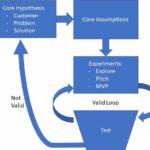All too often, entrepreneurs fall in love with their ideas. They envision a flawless product and pour time, money, and energy into building it from the start. Most entrepreneurs guard their ideas closely, hesitant to share it with others until it’s “ready”—fearing it might be stolen or criticized before it’s fully formed. But this secrecy and perfectionism mindset often backfires. When the product finally hits the market, it falls flat. Customers don’t respond. Assumptions go unvalidated. And worse—there’s no runway left to fix it. The result? A painful, expensive lesson.
This is why smart entrepreneurs resist the urge to build the “perfect” version out of the gate. Instead, they use a more disciplined approach built around Minimum Viable Products, or MVPs. But here’s the twist: an MVP isn’t a stripped-down version of your future product. It isn’t even functional. It’s a collection of mocked-up elements used strictly for testing assumptions—to gauge what users value and what they don’t—before writing a single line of code or investing heavily in development.
Think of MVPs as experiments. They can be landing pages, sketches, clickable prototypes, or demo videos. The goal isn’t to impress customers, but to learn. By putting these MVPs in front of early adopters, entrepreneurs can identify which features attract attention, which messages resonate, and which ideas flop.
Once these individual parts are tested and refined, they’re assembled into a Minimal Marketable Product (MMP)—a working version of the product that brings the validated components together. This version is often released to a limited audience, specifically to gather more feedback on the product as a whole. It’s a crucial step to evaluate how the different validated pieces work together in practice.
Related Post: How to Reduce Startup Risk with an MVP, Minimum Marketable Product, and Minimum Lovable Product
The real public debut doesn’t come until the Minimal Lovable Product (MLP). This is the first full release of the solution—designed not just to function, but to be embraced by a broader market. It represents the culmination of all the insights gathered from all the MVP and MMP testing. Though lean, it’s polished enough to deliver real value in a way that resonates emotionally with users. It’s not built on guesses, but on proven insights about what the market is ready for.
This approach is rooted in the Affordable Loss Principle—minimizing investment until your assumptions are proven to be accurate. It’s about discovering what users truly need and want—before investing heavily in something they may not.
When you build this way, you:
- Avoid overbuilding features users don’t want
- Discover what customers value most
- Make faster, smarter pivots
- Create better alignment between your product and your market
This strategy also keeps entrepreneurs grounded. It’s easy to get carried away building “the ocean”—an all-encompassing solution with every feature imaginable. But in reality, success comes from learning to ride the wave—leveraging the momentum of customer feedback and testing rather than trying to invent an entirely new paradigm from scratch. The phrase “Ride the wave, don’t build the ocean” is a reminder to work with what customers show you, not what you assume they want.
Consider some real-world examples:
- Twitter began as a side project within a podcasting company. Initially, it was just a simple internal tool to share short updates. Its usefulness became clear through usage—not planning.
- Airbnb tested their concept with three air mattresses in their own apartment. It wasn’t scalable, but it showed that people would pay for this kind of experience.
- Dropbox started by posting a short demo video to gauge interest in their file-sharing concept before any full-scale development.
- Zappos learned demand for online shoe shopping by posting photos of shoes from local stores. When someone ordered, the founder went out and bought the pair himself. No inventory, no warehouse—just a validated insight that people would indeed buy shoes online.
Each of these companies used early, lightweight MVPs to test hypotheses and refine their path based on real-world feedback—not gut feelings.
Here are some practical ways to apply this approach:
- Start with Questions: What do you need to know before you invest? What assumptions could sink the business?
- Design Experiments: Choose MVP formats (mock-ups, landing pages, videos) that will help you get answers quickly.
- Test One Thing at a Time: Don’t try to validate everything at once. Focus your MVPs on specific, high-risk assumptions.
- Analyze and Adapt: Use what you learn to shape your Minimal Marketable Product.
- Be Patient: Don’t rush to the public version. Take time to shape a Minimal Lovable Product that your users will truly appreciate.
By embracing a phased, feedback-driven approach—MVPs to MMP to MLP—you reduce risk and dramatically increase your odds of building something that truly connects with users.
Let your audience show you what they’re ready for. Don’t guess. Don’t overbuild. Don’t get too far ahead of what the market can absorb. Test. Learn. Iterate. Remember: ride the wave, don’t build the ocean.
Are you building an ocean or riding the wave?












